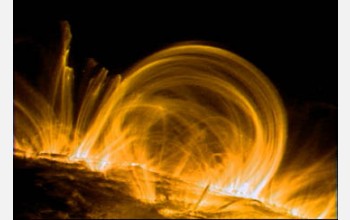|

Press Release 06-041
Scientists Issue Unprecedented Forecast of Next Sunspot Cycle

March 6, 2006
The next sunspot cycle will be 30 to 50 percent stronger than the last one, and begin as much as a year late, according to a breakthrough forecast using a computer model of solar dynamics developed by scientists at the National Center for Atmospheric Research (NCAR) in Boulder, Colo. The research results, funded by the National Science Foundation (NSF) and NASA, were published on-line on March 3 in the American Geophysical Union journal Geophysical Research Letters.
Scientists now predict that the next cycle, known as Cycle 24, will produce sunspots across an area slightly larger than 2.5 percent of the visible surface of the Sun. The cycle is projected to reach its peak about 2012, one year later than indicated by alternative forecasting methods that rely on statistics.
By analyzing recent solar cycles, the scientists also hope to forecast sunspot activity two solar cycles, or 22 years, into the future. The team is planning in the next year to issue a forecast of Cycle 25, which will peak in the early 2020s.
The researchers expect that predicting the Sun's cycles years in advance will lead to more accurate plans for solar storms, which can slow satellite orbits, disrupt communications, and bring down power systems.
The team has verified the information by using the relatively new technique of helioseismology, based in part on observations from NASA instruments. This technique tracks sound waves reverberating inside the Sun to reveal details about the interior, much as a doctor might use ultrasound to see inside a patient.
"Forecasting the solar cycle will help society anticipate solar storms," says Paul Bellaire, program director in NSF's division of atmospheric sciences, which funded the research. "Important discoveries are being made using helioseismology. Through this technique, we can image even the far side of the Sun."
The scientists gained additional confidence in the forecast by showing that the newly developed model could simulate the strength of the past eight solar cycles with more than 98 percent accuracy.
"The model has demonstrated the necessary skill to be used as a forecasting tool," says NCAR scientist Mausumi Dikpati, the leader of the forecast team at NCAR's High Altitude Observatory. The team also includes NCAR scientists Peter Gilman and Guiliana de Toma.
"This is a significant breakthrough with important applications, especially for satellite-dependent societies," says Gilman.
The Sun goes through approximately 11-year cycles, from peak storm activity to quiet, and back again. Solar scientists have tracked these cycles without being able to predict their relative intensity or timing, says Dikpati.
Solar storms are linked to twisted magnetic fields that suddenly snap and release tremendous amounts of energy. They tend to occur near dark regions of concentrated magnetic fields, known as sunspots.
The NCAR computer model, known as the Predictive Flux-transport Dynamo Model, draws on research indicating that the evolution of sunspots is caused by a current of plasma, or electrified gas, that circulates between the Sun's equator and its poles over a period of 17 to 22 years.
The plasma acts as a conveyor belt, transporting the imprints of sunspots from the previous two solar cycles. As they return toward the equator, they become stretched and twisted by the internal rotation of the Sun, gradually becoming less stable than the surrounding plasma. This eventually causes coiled-up magnetic field lines to rise up, tear through the Sun's surface, and create new sunspots, beginning the cycle again.
-NSF-

Media Contacts
Cheryl Dybas, NSF (703) 292-7734 cdybas@nsf.gov
Dwayne Brown, NASA (202) 358-1726 dwayne.c.brown@nasa.gov
Anatta , NCAR (303) 497-8604 anatta@ucar.edu
Harvey Leifert, GRL/AGU (202) 777-7507 hleifert@agu.org
Related Websites
High Altitude Observatory: http://www.hao.ucar.edu

The National Science Foundation (NSF) is an independent federal agency that supports fundamental research and education across all fields of science and engineering. In fiscal year (FY) 2009, its budget is $9.5 billion, which includes $3.0 billion provided through the American Recovery and Reinvestment Act. NSF funds reach all 50 states through grants to over 1,900 universities and institutions. Each year, NSF receives about 44,400 competitive requests for funding, and makes over 11,500 new funding awards. NSF also awards over $400 million in professional and service contracts yearly.
 Get News Updates by Email Get News Updates by Email
Useful NSF Web Sites:
NSF Home Page: http://www.nsf.gov
NSF News: http://www.nsf.gov/news/
For the News Media: http://www.nsf.gov/news/newsroom.jsp
Science and Engineering Statistics: http://www.nsf.gov/statistics/
Awards Searches: http://www.nsf.gov/awardsearch/
| 

